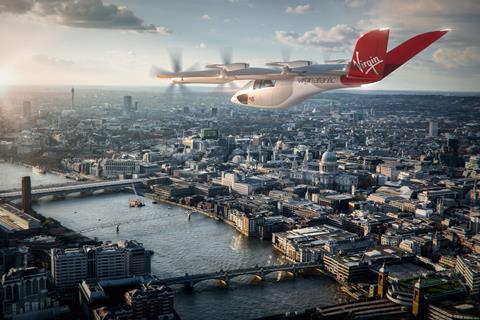UK civil aviation regulators are attempting to shape the safety culture of advanced air mobility operations – a sector that will not begin carrying paying passengers for at least another three years – through the creation of a cross-industry forum.
Launched today by the Civil Aviation Authority (CAA), the international consortium covers the nascent market for electric vertical take-off and landing (eVTOL) aircraft and brings together manufacturers, safety experts and current operators of fixed- and rotary-wing aircraft who are planning to move into the new segment.

The eVTOL Safety Leadership Group (eVSLG), includes aircraft developers Joby and Vertical Aerospace, alongside operators Bristow Helicopters and Virgin Atlantic Airways, both of whom have committed to Vertical’s VA-X4 eVTOL.
Co-chairing the group is Rick Newson, head of the CAA’s Rapid Capabilities Office, alongside Matt Rhodes, director of UK and Turkmenistan oil and gas at Bristow.
Rhodes is also co-chair of the Offshore Helicopter Safety Leadership Group on which the eVSLG is partly modelled.
Newson says the establishment of the eVSLG is a “golden opportunity to establish a safety culture in a brand-new sector of aviation”.
It will, he says, provide a forum for the sector’s “future safety leaders” to meet and share potential risks and best practice in a proactive manner.
“The vertical-flight industry has evolved significantly over the last half century. Many of the lessons learned, practices and procedures that have been developed over this period, will undoubtedly read across into this new era of powered vertical flight,” adds Rhodes, who hails the group’s “collaborative approach”.
The eVSLG’s inaugural meeting will take place in November, says Newson, where it will hammer out its terms of reference and “start to identify how we can best share experiences and safety information”.
While operational data will clearly be thin on the ground initially, Newson believes this will come over time, and is hopeful that aircraft developers will be willing to share certain information with the forum unencumbered by concerns around intellectual property.
Many eVTOL aircraft designs blend elements of both rotary- and fixed-wing flight and the inclusion of airline Virgin Atlantic – which operates nothing smaller than a Boeing 787 – will bring a unique perspective to the group, says Newson.
“The very reason I was keen to see a large airline involved is that they have some very robust safety management systems in place,” he says.
The CAA claims the eVSLG is the first body of its kind for the sector globally, but Newson is keen that it share expertise with similar groups as they are established elsewhere.
Other organisations represented within the eVSLG include the UK Air Accidents Investigation Branch, British Helicopter Association, fractional operator Flexjet, the General Aviation Safety Council, and air navigation service provider NATS.


























